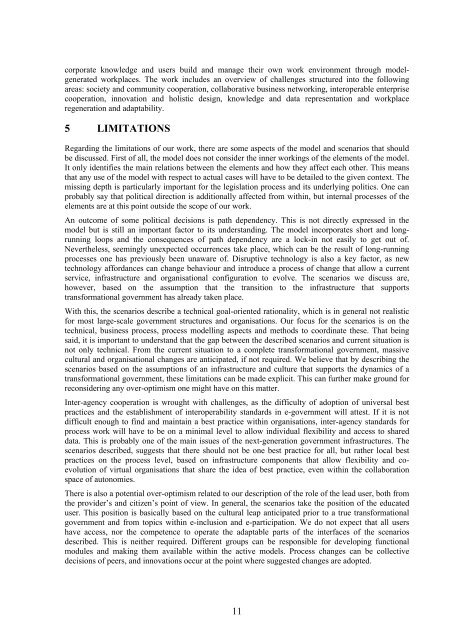Multi-channel provisioning of public services - Department of ...
Multi-channel provisioning of public services - Department of ...
Multi-channel provisioning of public services - Department of ...
Create successful ePaper yourself
Turn your PDF publications into a flip-book with our unique Google optimized e-Paper software.
corporate knowledge and users build and manage their own work environment through modelgenerated<br />
workplaces. The work includes an overview <strong>of</strong> challenges structured into the following<br />
areas: society and community cooperation, collaborative business networking, interoperable enterprise<br />
cooperation, innovation and holistic design, knowledge and data representation and workplace<br />
regeneration and adaptability.<br />
5 LIMITATIONS<br />
Regarding the limitations <strong>of</strong> our work, there are some aspects <strong>of</strong> the model and scenarios that should<br />
be discussed. First <strong>of</strong> all, the model does not consider the inner workings <strong>of</strong> the elements <strong>of</strong> the model.<br />
It only identifies the main relations between the elements and how they affect each other. This means<br />
that any use <strong>of</strong> the model with respect to actual cases will have to be detailed to the given context. The<br />
missing depth is particularly important for the legislation process and its underlying politics. One can<br />
probably say that political direction is additionally affected from within, but internal processes <strong>of</strong> the<br />
elements are at this point outside the scope <strong>of</strong> our work.<br />
An outcome <strong>of</strong> some political decisions is path dependency. This is not directly expressed in the<br />
model but is still an important factor to its understanding. The model incorporates short and longrunning<br />
loops and the consequences <strong>of</strong> path dependency are a lock-in not easily to get out <strong>of</strong>.<br />
Nevertheless, seemingly unexpected occurrences take place, which can be the result <strong>of</strong> long-running<br />
processes one has previously been unaware <strong>of</strong>. Disruptive technology is also a key factor, as new<br />
technology affordances can change behaviour and introduce a process <strong>of</strong> change that allow a current<br />
service, infrastructure and organisational configuration to evolve. The scenarios we discuss are,<br />
however, based on the assumption that the transition to the infrastructure that supports<br />
transformational government has already taken place.<br />
With this, the scenarios describe a technical goal-oriented rationality, which is in general not realistic<br />
for most large-scale government structures and organisations. Our focus for the scenarios is on the<br />
technical, business process, process modelling aspects and methods to coordinate these. That being<br />
said, it is important to understand that the gap between the described scenarios and current situation is<br />
not only technical. From the current situation to a complete transformational government, massive<br />
cultural and organisational changes are anticipated, if not required. We believe that by describing the<br />
scenarios based on the assumptions <strong>of</strong> an infrastructure and culture that supports the dynamics <strong>of</strong> a<br />
transformational government, these limitations can be made explicit. This can further make ground for<br />
reconsidering any over-optimism one might have on this matter.<br />
Inter-agency cooperation is wrought with challenges, as the difficulty <strong>of</strong> adoption <strong>of</strong> universal best<br />
practices and the establishment <strong>of</strong> interoperability standards in e-government will attest. If it is not<br />
difficult enough to find and maintain a best practice within organisations, inter-agency standards for<br />
process work will have to be on a minimal level to allow individual flexibility and access to shared<br />
data. This is probably one <strong>of</strong> the main issues <strong>of</strong> the next-generation government infrastructures. The<br />
scenarios described, suggests that there should not be one best practice for all, but rather local best<br />
practices on the process level, based on infrastructure components that allow flexibility and coevolution<br />
<strong>of</strong> virtual organisations that share the idea <strong>of</strong> best practice, even within the collaboration<br />
space <strong>of</strong> autonomies.<br />
There is also a potential over-optimism related to our description <strong>of</strong> the role <strong>of</strong> the lead user, both from<br />
the provider’s and citizen’s point <strong>of</strong> view. In general, the scenarios take the position <strong>of</strong> the educated<br />
user. This position is basically based on the cultural leap anticipated prior to a true transformational<br />
government and from topics within e-inclusion and e-participation. We do not expect that all users<br />
have access, nor the competence to operate the adaptable parts <strong>of</strong> the interfaces <strong>of</strong> the scenarios<br />
described. This is neither required. Different groups can be responsible for developing functional<br />
modules and making them available within the active models. Process changes can be collective<br />
decisions <strong>of</strong> peers, and innovations occur at the point where suggested changes are adopted.<br />
11
















